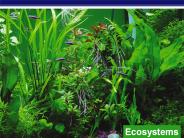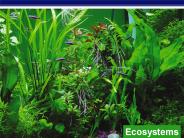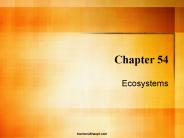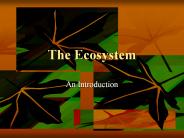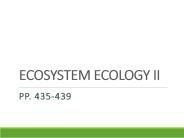Ecosystem PowerPoint PPT Presentations
All Time
Recommended
Ecosystems, ecosystem management, ecosystem health
| free to view
Discuss the delineation of large ecosystems on the basis of natural ... Anadromous. Fish Range. 13. Inclusion of Humans. as Part of Ecosystem. 127274928. Total ...
| free to view
Chapter 6: Ecosystems and Ecosystem Management Watershed The whole region or extent of land which contributes to the supply of a river, lake or ocean.
| free to view
AQUATIC ECOSYSTEMS LANDSCAPE ECOLOGY RESTORATION ECOLOGY ECOSYSTEM MANAGEMENT Chapters 8 and 10 What are the basic needs of aquatic biota? CO2 O2 Sunlight Nutrients ...
| free to view
San Miguel Island Fur Seal. Maximum biomass of key commercial species in the ecosystem ... objectives for ecosystem management should be set for the long term, ...
| free to view
AQUATIC ECOSYSTEMS LANDSCAPE ECOLOGY RESTORATION ECOLOGY ECOSYSTEM MANAGEMENT Chapters 8 and 10 What are the basic needs of aquatic biota? CO2 O2 Sunlight Nutrients ...
| free to view
... all the living and nonliving parts of an environment Biotic ... oceans, estuaries, and ... design template Ecosystems What effects do biotic and abiotic factors ...
| free to view
Sci.7.12B, Sci.7.8B and Sci.7.12D What is an Ecosystem? An ecosystem is composed of all the living and nonliving things that interact in a particular area.
| free to view
BIOL 4120: Principles of Ecology Lecture 18: Ecosystem Ecology (Energy in the Ecosystem) Dafeng Hui Office: Harned Hall 320 Phone: 963-5777 Email: dhui@tnstate.edu
| free to download
The influence of movement dynamics on ecosystem structure: Suckers as ecosystem engineers Michael T. Booth, Alex S. Flecker, Nelson G. Hairston, Jr.
| free to download
Definition of Ecosystem ... no inherent definition. of spatial dimension. Gallatin ... Forest provide wood, food, habitat, fuel, pharmaceuticals, recreation ...
| free to view
What effects do biotic and abiotic factors have on an ecosystem? Diane Gioia Bell s Crossing Elementary What makes up an ecosystem? Ecosystem all the living and ...
| free to view
This includes diversity within species, between species, and of ecosystems ... Ecosystem services are the benefits people obtain from ecosystems ...
| free to download
Evaluating Cumulative Ecosystem Response of the Columbia River Estuary Ecosystem to Past and Current
| free to view
This presentation is about Ecosystem. Have a good learning... Thank you
| free to download
PowerPoint Presentation ... Ecosystems
| free to download
Ecosystems What do you know about ecosystems?
| free to download
PowerPoint Presentation ... Ecosystems
| free to download
Ecosystem HO Pui-sing Contents What is an ecosystem Three major principles of ecosystem Components of an ecosystem Abiotic components Biotic components Movement of ...
| free to download
Ecosystems Aim- What are ecosystems and how do they work?
| free to view
Chapter 54 Ecosystems Ecosystems Ecosystems are all of the organisms living in a community along with the abiotic factors with which they interact.
| free to download
Ecosystems Georgia Performance Standards S4L1: Students will describe the roles of organisms and the flow of energy within an ecosystem. Identify roles of producers ...
| free to download
Ecosystems 4th grade Science Ecosystems Ecosystems include both living and nonliving things. Nonliving things include water, rocks, air, light, and soil.
| free to view
Ecosystem Biotic (communities) and abiotic (environment) components within a given area Integrative Process-centered (energy flow and nutrient cycles)
| free to view
Ecosystems Ecosystems have Living and Nonliving Components Each population in an ecosystem has a range of tolerance to variations in its physical and chemical ...
| free to view
ECOSYSTEMS WHAT IS ECOLOGY? Ecology is the study of relationships between living things and between living things and their environment. WHAT IS AN ECOSYSTEM?
| free to view
Chapter 51 Ecosystems Ecosystems Population: all the individuals of a certain species that live in a particular area Community: all the different species that ...
| free to download
Ecosystems. Groups of living things and the environment they live in make up an ecosystem. Some ecosystems include forests, ponds, and streams. ...
| free to view
Arial ecosystems Ecosystem What is a Population? What is a Community? What is a Ecosystem? What is Ecology? Non ...
| free to download
detritus = dead animals and plant tissue, consumed by 1 decomposers (bacteria, ... Large amounts of S leave ecosystem as detritus (washes into streams) ...
| free to view
Ecosystems. Photosynthesis. Plants take in energy from the sun. ... In most ecosystems, plants of the main population are where organisms interact. ...
| free to view
CHAPTER 55 ECOSYSTEMS A terrarium, an example of an ecosystem Figure 54.2 Fungi decomposing a log Energy Flow Inorganic Nutrients Table 55-1 Primary Productivity ...
| free to view
Ecosystems Table of Contents 1. Process Skills 2. Cells 3. Classifying Animals 4. ECOSYSTEMS----- Make this the next clean page in your journal Ecosystem ...
| free to view
Excretion & egestion. 2. Respiration. 3. Removal of wastes. 6.3 Energy flow within an ecosystem ... Excretion & egestion. 2. Respiration. 3. most energy is lost ...
| free to view
Ecosystems Reading: Freeman Chapter 54 An ecosystem is the unit composed of all the living things in a single place at a given time, in addition to, the important non ...
| free to view
What causes ecosystems to change? Changes caused by humans: Water pollution. Air ... How can humans help to prevent changes in ecosystems? Use resources wisely ...
| free to view
Presented by: Ms. Hill Environment Education Officer An ecosystem is a community of plants, animals and smaller organisms that live, feed, reproduce and interact in ...
| free to view
solution ecosystem if silicon valley were a country, it would be the 8th largest economy in the world. solution ecosystem and solution ecosystems solution ecosystem ...
| free to view
Ecosystem Components BIOTIC Components of an Ecosystem PRODUCERS CONSUMERS DECOMPOSERS (type of Consumer) PRODUCERS (autotrophs) Terrestrial: Green plants Aquatic ...
| free to view
The Ecosystem An Introduction Ecosystem A community of interdependent organisms and the interactions with the physical environment in which they live.
| free to download
Connected Ecosystem Michele Kissinger Moorea Coral Reef Long Term Ecological Research Program
| free to view
ECOSYSTEM ECOLOGY II PP. 435-439 PROPERTIES OF AN ECOSYSTEM Species Richness Species Evenness Species- Area Effect 1. Species Richness: # of different types of ...
| free to download
Aquatic Ecosystems ... Wetland Bogs Form in depressions left by sheets of ice. ... including southern Florida and Hawaii.
| free to download
Ecosystem Recycling Chapter 9 Section 9.2 and 9.3 * * The Carbon Cycle Carbon is cycled through ecosystems mainly through the processes of photosynthesis and cell ...
| free to download
Ecosystem Biodiversity By: Kaitlyn Fisher A food chain A food chain would not be sustainable to an ecosystem because if one animal became extinct, the animal that ate ...
| free to view
Energy enters most ecosystems in the form of sunlight. ... Ecosystem ecologists view ecosystems as transformers of energy and processors of ...
| free to view
Ecosystem Name Ecosystem Features Producers Decomposers Primary Consumers Secondary Consumers Dangers to the Ecosystem Ecosystem Name Ecosystem Features Producers ...
| free to download
Introducing Ecosystems Introducing Ecosystems Ecosystem: all the living organisms in an area and their non-living environment Introducing Ecosystems Ecosystem: all ...
| free to view
Aquatic Ecosystems Chapter 7 Flowing water zones- (Planet Earth) Source: Tend to be narrow, swift, clear, cold, nutrient poor, and highly oxygenated; not very ...
| free to download
Ecosystem Journal Designed by Team members & jobs Calendar of Due Dates Team Meeting Agenda: __ Date: Leader: Date: Leader: Team Meeting Agenda __ Team Meeting Agenda ...
| free to view
Ecosystem Interactions Types of Interactions Predation: one organism consumes another for food Competition: when more than one organism uses a resource at the same ...
| free to view

















